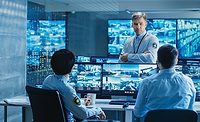How existing physical security systems can help campuses mitigate the spread of COVID-19

The requirements being placed on colleges and universities for the 2020-2021 academic year are unprecedented. In addition to providing education, housing, and recreational activities, they’re now also being tasked with mitigating the spread of COVID-19. To make their situation more complex, they are also facing budgetary challenges.
Many higher education institutions have seen a decline in on-campus residency, dining, and parking along with deferred enrollment which has resulted in reduced revenue. At the same time, they have had to decrease class sizes, transform non-academic spaces into classrooms, and improve ventilation systems. All of which come with mounting expenses. It’s not surprising that many are hesitant to address these requirements by investing in entirely new technology that will have no use once a treatment or a vaccine for COVID-19 is found.
Rather than invest in unproven solutions, colleges and universities are looking to existing technology to address their evolving needs. They are finding that the ability to adapt what they already have is a tremendous benefit.
Using physical security systems for occupancy management
Research has shown that one of the keys to controlling the spread of the virus is reducing the time individuals spend in close contact in enclosed spaces. This can be a real challenge for college and university campuses. Many are focusing on occupancy management. This means first knowing the maximum allowable capacity in enclosed spaces as set by local government and the medical community. Then they must count exactly how many people are in each environment at all times. And finally, they must be able to quickly decompress a space before it reaches its allowable threshold.
Given that physical security systems are already helping colleges and universities keep track of who is on their campuses, it makes sense to think about ways to use these systems for managing occupancy and density. Adding analytics to an existing video surveillance system gives an institution the baseline technology necessary to achieve effective occupancy management of their spaces.
How to manage enclosed spaces on campus
The first step is counting people. Fortunately, the cameras in a physical security system can provide an effective count when pointed in the right direction. This can be as straightforward as adjusting a front-facing camera at an entrance or exit to face downward. In this position, the camera can more easily delineate people as they pass under it as opposed to capturing groups as they approach. If a campus wants to keep their cameras facing forward, they can add LiDAR sensors, which use light to count people and are 95-99% accurate.
But, it is important to understand that occupancy management is more than just people counting. Institutions must also be able to act on the information that their systems are gathering to ensure that they’re always complying with capacity guidelines.
This is why being able to automate alerts is important. Instead of hiring extra personnel and relying on manual people counting, colleges and universities can use video analytics to manage occupancy. With the data collected by video cameras or LiDAR sensors, video analytics tracks occupancy in real-time and then automatically sends out alerts when areas on campus are reaching capacity. If necessary, security personnel can take steps to begin decompression.
Occupancy management can be further improved by unifying video surveillance and analytics with access control systems (ACS). Once thresholds have been established for all the areas on campus, institutions can use their ACS to automatically manage the number of people in an area by setting schedules for all members of the community. Faculty, staff, and students would be assigned specific times when they can enter spaces, like cafeterias or gym facilities. Then, if someone uses their access control card outside of their scheduled time or if the area is already at capacity, the ACS will ensure compliance by not allowing them in.
Supporting contact tracing
We also know that contact tracing is important for stopping the spread of the virus. But doing it manually is time consuming, inefficient, and expensive. What’s worse, it’s prone to error, which means that people might not be informed about potential exposure.
Instead, using the data collected by an ACS gives institutions a clear picture of where faculty, students, and staff have been and when. Working with this data, campuses can then determine who else was in the same space and for how long. The system can then notify any individuals who may have been exposed to the virus that they should check for any symptoms, get tested, or self-quarantine.
Increasingly, we are seeing a greater focus on unifying disparate technologies and systems and then leveraging this unification to aggregate data. In this way, colleges and universities can use occupancy management to make data-driven decisions that keep faculty, staff, and students safe. And, whether it will involve solving challenges associated with intrusions on campus or attendance reporting at events, these technologies that institutions use today to mitigate the spread of COVID-19 will help to further secure their campuses in the future.
Looking for a reprint of this article?
From high-res PDFs to custom plaques, order your copy today!







